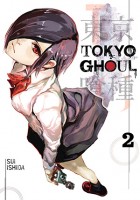I’m fresh out of snappy intros, so I’ll cut to the chase: this week’s column looks at Inuyashiki, The Kurosagi Corpse Delivery Service Omnibus Edition, and Tokyo Ghoul.
 Inuyashiki, Vol. 1
Inuyashiki, Vol. 1
By Hiroya Oku
Rated OT, for older teens (16+)
Kodansha Comics, $12.99
Bette Davis famously declared that “Old age is no place for sissies,” a statement borne out by the first chapters of Hiroya Oku’s grimly compelling Inuyashiki. Its hero, a 58-year-old salaryman, is a picture of despair: his family loathes him, his co-workers ignore him, and his health is failing. In a blinding flash of light, however, his life changes. He wakes up to discover that his memories are intact but his body has changed; his once-frail limbs and failing eyes are now military-grade weapons, capable of withstanding lethal force. What to do with this gift? That question animates the final pages of volume one, as Ichiro tests his new body’s limits for the first time.
This final scene is a neat illustration of what’s good — and not so good — about Inuyashiki. Oku stages a suspenseful confrontation between Ichiro and a gang of teenage thugs; though we sense that Ichiro will prevail, how he gains the upper hand is a nifty surprise made more effective by Oku’s meticulously detailed illustrations. The incident that precipitates the showdown, however, is saddled with a heavy-handed script; Oku stokes the reader’s sense of righteous indignation by revealing that the thugs’ intended victim is a good but vulnerable man. By overemphasizing the victim’s inherent decency, Oku reduces him to a saintly caricature, a problem that also mars Ichiro’s early interactions with his family. (His kids are such ungrateful jerks you may root for Ichiro to use his powers on them.)
Even if Ichiro’s catharsis is less earned than contrived, watching him transform from terminal sad-sack to indestructible bad-ass is a deeply satisfying experience. He’s found his purpose and his spine, even if it’s taken him 58 years to do so. Now that’s a fantasy that any middle-aged reader can get behind.
The verdict: Pour yourself a scotch before reading; you’ll need the emotional fortification to navigate the early chapters.
 The Kurosagi Corpse Delivery Service Omnibus Edition, Book One
The Kurosagi Corpse Delivery Service Omnibus Edition, Book One
By Eiji Ōtsuka and Housui Yamazaki
Rated OT, for older teens (16+)
Dark Horse, $19.99
Scooby Doo for grown-ups — that’s how I’d describe The Kurosagi Corpse Delivery Service, a macabre comedy about five cash-strapped college students who drive around in a van solving supernatural mysteries. The Kurosagi gang’s bread-and-butter are mysterious (and often violent) deaths. Through dowsing and channeling, they discover how and why their “clients” died, enabling the victims’ spirits to cross over to the other side.
The new omnibus edition — which collects the first three volumes of KCDS — includes two of the series’ best stories: “Lonely People,” in which the gang stumbles across a portable altar with a mummy inside, and “Crossing Over,” in which the gang searches for the victim of an organ harvesting ring. Though the denouement of both “deliveries” include a few gruesome panels, the deadpan dialogue, expressive character designs, and snappy pacing prevent KCDS from sinking to the level of torture porn; the horrific imagery functions as a rim shot or an exclamation mark, not the main attraction. The self-contained nature of the stories is another plus: you can begin your KCDS odyssey almost anywhere in the series and still grasp what’s happening, though the crew’s origin story (“Less Than Happy,” the very first chapter) offers an interesting window into Buddhist university culture in Japan.
The verdict: If you haven’t tagged along on one of the Kurosagi crew’s “deliveries,” the omnibus edition gives you an economical way to do so.
Review copy provided by Dark Horse.
 Tokyo Ghoul, Vol. 2
Tokyo Ghoul, Vol. 2
By Sui Ishida
Rated OT, for older teens (16+)
VIZ Media, $12.99
The first volume of Tokyo Ghoul reads like an urban legend: Ken Kaneki, earnest college student, goes out for dinner with a pretty girl, but wakes up in the hospital with a brand-new set of organs… that used to belong to his date. Within a few days of his release, Kaneki begins turning into a flesh-eating monster, a side effect of the transplant surgery. Volume two picks up where volume one left off: now caught between the human and demon worlds, Kaneki casts his lot with the demons of cafe Anteiku. They teach him tricks for passing as a human, and warn him about the deep divide between the ghouls who embrace their predator status and those who feel some kinship with humanity.
Although volume two introduces several new and potentially interesting characters, Kaneki’s wet-blanket personality continues to put a damper on the story: he whines and frets and refuses to do anything that might compromise the reader’s good opinion of him. As anyone who’s read Death Note knows, however, a charismatic, intelligent protagonist doesn’t have to be good or right to command the audience’s sympathy. Someone who’s flawed, misguided, or tempted to abuse a new-found power might actually invite more self-identification than a goody two-shoes lead.
The verdict: Tokyo Ghoul isn’t bad, just a little too obvious to sustain my interest.
Review copy provided by VIZ Media.
Reviews: Joe McCulloch looks at the new English-language version of Comics Zenon, Michelle Smith and Anna N. post a fresh set of Bookshelf Briefs, and Vernieda Vergara asks if Bleach has overstayed its welcome.
Connie on vol. 19 of Bakuman (Slightly Biased Manga)
Julie on The Desert Lord’s Bride (Manga Maniac Cafe)
Ash Brown on Dr. Makumakuran and Other Stories (Experiments in Manga)
Connie on vol. 3 of Earthian (Slightly Biased Manga)
Kory Cerjak on vol. 47 of Fairy Tail (The Fandom Post)
James Ristig on Full Metal Alchemist (How to Love Comics)
Matthew Alexander on vol. 1 of Hayate Cross Blade (The Fandom Post)
Connie on vol. 11 of Kamisama Kiss (Slightly Biased Manga)
Rebecca Silverman on vol. 23 of Kaze Hikaru (Anime News Network)
Lesley Aeschliman on vol. 1 of Komomo Confisere (WatchPlayRead)
Jordan Richards on vol. 1 of Komomo Confiserie (AiPT!)
Connie on vol. 14 of The Kurosagi Corpse Delivery Service (Slightly Biased Manga)
Angel Cruz on vols. 1-2 of Love at Fourteen (Women Write About Comics)
Lori Henderson on vols. 1-3 of Neon Genesis Evangelion (Manga Xanadu)
Ken H. on vol. 1 of Ninja Slayer Kills! (Sequential Ink)
Matthew Warner on vol. 10 of Nisekoi: False Love (The Fandom Post)
Connie on vol. 4 of No. 6 (Slightly Biased Manga)
Jocelyn Allen on Nobara (Brain vs. Book)
David Brooke on vol. 1 of Noragami: Stray God (AiPT!)
Lesley Aeschliman on vol. 1 of One-Punch Man (WatchPlayRead)
Kristin on vols. 1-2 of One-Punch Man (Comic Attack)
Jordan Richards on vol. 2 of One-Punch Man (AiPT!)
Matthew Warner on vol. 18 of Rin-ne (The Fandom Post)
Sarah on vol. 1 of The Royal Tutor (Anime UK News)
Al Sparrow on vol. 1 of So I Can’t Play H (Comic Spectrum)
Helen on Sweetness and Lightning (Organization Anti-Social Geniuses)
Dustin Cabeal on vol. 1 of Tokyo Ghoul (Comic Bastards)
Matthew Warner on vol. 1 of Tokyo Ghoul (The Fandom Post)
Connie on vol. 6 of Toradora! (Slightly Biased Manga)
Sheena McNeil on vol. 29 of Toriko (Sequential Tart)
Adam Capps on vol. 1 of Ultraman (BentoByte)
Michael Burns on vol. 3 of Yamada-Kun and the Seven Witches (AniTAY)













 10. ASTRAL PROJECT
10. ASTRAL PROJECT 9. CHIKYU MISAKI
9. CHIKYU MISAKI 8. THE NAME OF THE FLOWER
8. THE NAME OF THE FLOWER 7. SHIRLEY
7. SHIRLEY 6. KIICHI AND THE MAGIC BOOKS
6. KIICHI AND THE MAGIC BOOKS 5. PRESENTS
5. PRESENTS 4. GON
4. GON 3. FROM EROICA WITH LOVE
3. FROM EROICA WITH LOVE 2. SWAN
2. SWAN 1. EMMA
1. EMMA